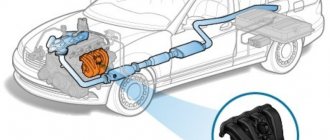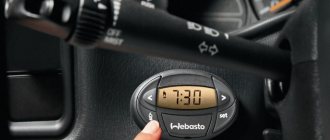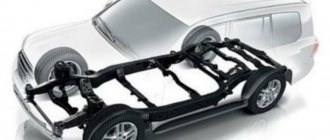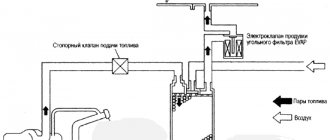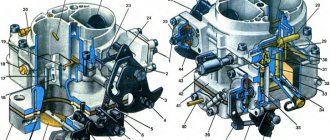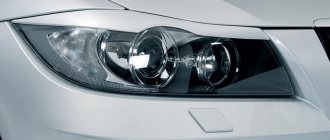With the advent of self-propelled vehicles, the risk of accidents on the roads has increased. Every new car, even a budget model, is tailored to the growing demands of modern drivers. So, the car can get a more powerful or economical power unit, improved suspension, a different body and a variety of electronics. Since cars on the roads are a potential source of danger, each manufacturer equips its products with all kinds of systems to ensure safety.
This list includes both active and passive safety systems. An example of this is airbags (their structure and operating principle are described in more detail in another article ). However, some equipment can be classified as both a safety and comfort system. This category includes the head light of the car. We no longer imagine a single vehicle without external lighting. This system allows you to continue driving even in the dark, since the road is visible thanks to a directed light beam in front of the car.
Modern cars can use different light bulbs to improve road illumination (standard lamps do a poor job of this task, especially at dusk). Their varieties and work are described in detail here . Despite the fact that the new headlight elements demonstrate better lighting characteristics, they are still far from ideal. For this reason, leading car manufacturers are developing different systems that allow them to achieve the optimal parameter between safe and efficient light.
Such developments include adaptive light. In classic vehicles, the driver can switch the low or high beam, as well as turn on the dimensions (read about what function they perform separately ). But such switching in many cases does not provide good visibility of the road. For example, city mode does not allow the use of high beams, and in low beams the road is often difficult to see. On the other hand, switching to low beam often makes the side of the road invisible, which is why a pedestrian may be too close to the car, and the driver may not notice him.
A practical solution is to make optics that provide the perfect balance between illumination of the roadside and safety for oncoming traffic. Let's look at the device, types and operating features of adaptive optics.
What are adaptive headlights and adaptive lighting?
Adaptive optics is a system that changes the direction of the light beam depending on the road situation. Each manufacturer implements this idea in its own way. Depending on the modification of the device, the headlight independently changes the position of the light bulb relative to the reflector, turns on/off some LED elements, or changes the brightness of the illumination of a certain section of the road.
There are several modifications of such systems that work differently and are adapted for different types of optics (matrix, LED, laser or LED type). This device operates automatically and does not require manual configuration. For efficient operation, the system is synchronized with other transport systems. The brightness and position of the light elements are controlled by a separate electronic unit.
Here are just a few situations in which standard light does not do its job:
- Driving on the highway outside the city allows the driver to use high beams. An important condition for this is the absence of oncoming traffic. However, some drivers do not always notice that they are driving in high-light mode and blind oncoming traffic participants (or in the mirrors of drivers of cars in front). To increase safety in such situations, the adaptive headlights automatically switch the lights.
- When the car enters a sharp turn, the classic headlights shine exclusively forward. For this reason, the driver sees the road around the bend worse. The automatic light reacts to the direction in which the steering wheel is turned and, accordingly, directs the light beam to where the road leads.
- A similar situation occurs when a car goes up a hill. In this case, the light shines upward and does not illuminate the road. And if another car is driving towards you, the harsh light will definitely blind the driver. The same effect is observed when overcoming passes. An additional drive in the headlights allows you to change the angle of the reflector or the light element itself so that the road is always as visible as possible. In this case, the system uses a special sensor that detects the inclination of the road surface and adjusts the operation of the optics accordingly.
- In city mode at night, when driving through an unlit intersection, the driver sees only other vehicles. If you need to turn, it is extremely difficult to notice pedestrians or cyclists on the roadway. In such a situation, the automation activates an additional spotlight, which illuminates the turning area of the car.
The peculiarity of different modifications is that in order to activate certain functions, the speed of the machine must correspond to a certain value. In some situations, this helps drivers adhere to speed limits allowed within populated areas.
Origin story
For the first time, headlight technology capable of changing the direction of the light beam was used on the iconic Citroen DS model, starting in 1968. The car received a modest but very original system that turned the headlight reflectors in the direction of the steering wheel. This idea was brought into reality by engineers of the French company Cibie (founded in 1909). Today this brand is part of the Valeo company.
Although at that time the device was far from ideal due to the tight physical connection between the headlight drive and the steering wheel, that development formed the basis for all subsequent systems. For many years, motorized headlights were considered more of a toy than a useful piece of equipment. All companies that tried to use this idea faced one single problem that did not allow them to improve the system. Due to the tight connection between the headlights and the steering, the light still adapted to turns late.
After the French company founded by Leon Sibier became part of Valeo, this technology received a “second wind”. The system was improved so quickly that not a single manufacturer was able to get ahead of the release of new things. Thanks to the introduction of this mechanism into the external lighting system of vehicles, driving a car at night has become safer.
The first truly effective system was AFS. The new product appeared on the market under the Valeo brand in 2000. The first modification also had a dynamic drive that responded to steering wheel turns. Only in this case the systems did not have a rigid mechanical connection. The degree by which the headlight turned depended on the speed of the car. The first model to be equipped with such equipment was the Porsche Cayenne. This type of equipment was called the FBL system. If the car was moving at high speed, the headlights could be turned in the direction of the turn by a maximum of 45 degrees.

